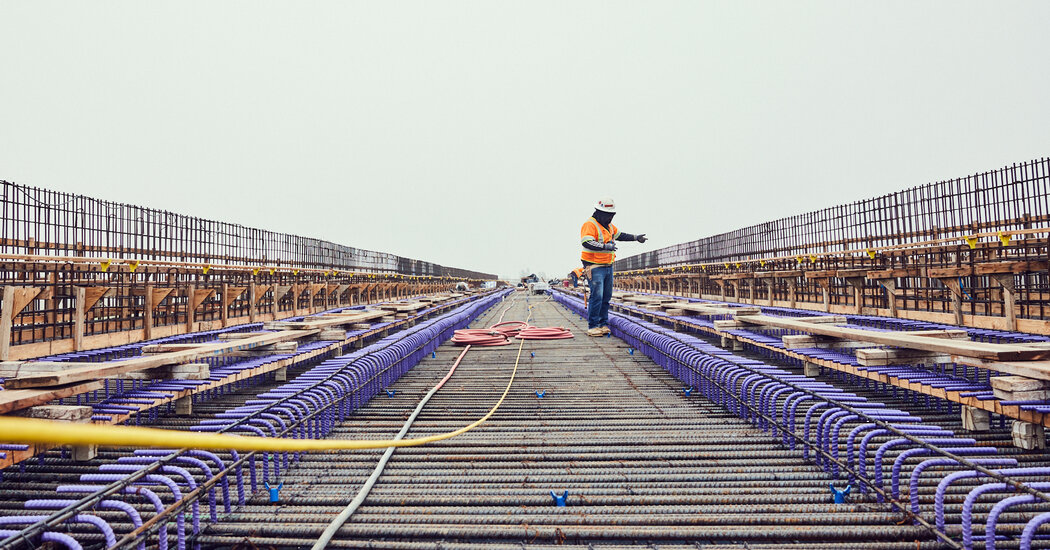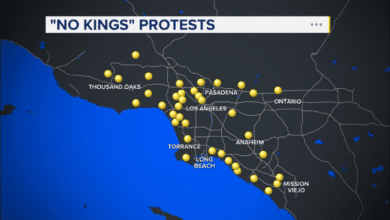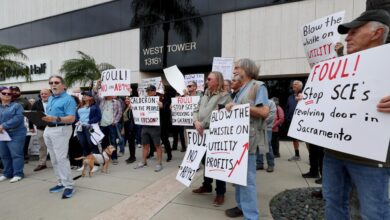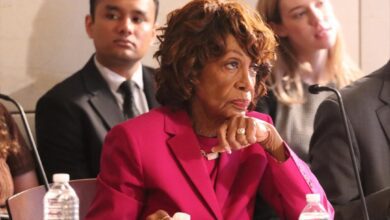How California’s Bullet Train Went Off the Rails

LOS ANGELES — Building the nation’s first bullet train, which would connect Los Angeles and San Francisco, was always going to be a formidable technical challenge, pushing through the steep mountains and treacherous seismic faults of Southern California with a series of long tunnels and towering viaducts.
But the design for the nation’s most ambitious infrastructure project was never based on the easiest or most direct route. Instead, the train’s path out of Los Angeles was diverted across a second mountain range to the rapidly growing suburbs of the Mojave Desert — a route whose most salient advantage appeared to be that it ran through the district of a powerful Los Angeles county supervisor.
The dogleg through the desert was only one of several times over the years when the project fell victim to political forces that have added billions of dollars in costs and called into question whether the project can ever be finished.
Now, as the nation embarks on a historic, $1 trillion infrastructure building spree, the tortured effort to build the country’s first high-speed rail system is a case study in how ambitious public works projects can become perilously encumbered by political compromise, unrealistic cost estimates, flawed engineering and a determination to persist on projects that have become, like the crippled financial institutions of 2008, too big to fail.
A review of hundreds of pages of documents, engineering reports, meeting transcripts and interviews with dozens of key political leaders show that the detour through the Mojave Desert was part of a string of decisions that, in hindsight, have seriously impeded the state’s ability to deliver on its promise to create a new way of transporting people in an era of climate change.
Political compromises, the records show, produced difficult and costly routes through the state’s farm belt. They routed the train across a geologically complex mountain pass in the Bay Area. And they dictated that construction would begin in the center of the state, in the agricultural heartland, not at either of the urban ends where tens of millions of potential riders live.
The pros and cons of these routing choices have been debated for years. Only now, though, is it becoming apparent how costly the political choices have been. Collectively, they turned a project that might have been built more quickly and cheaply into a behemoth so expensive that, without a major new source of funding, there is little chance it can ever reach its original goal of connecting California’s two biggest metropolitan areas in two hours and 40 minutes.
When California voters first approved a bond issue for the project in 2008, the rail line was to be completed by 2020, and its cost seemed astronomical at the time — $33 billion — but it was still considered worthwhile as an alternative to the state’s endless web of freeways and the carbon emissions generated in one of the nation’s busiest air corridors..
Fourteen years later, construction is now underway on part of a 171-mile “starter” line connecting a few cities in the middle of California, which has been promised for 2030. But few expect it to make that goal.
Meanwhile, costs have continued to escalate. When the California High-Speed Rail Authority issued its new 2022 draft business plan in February, it estimated an ultimate cost as high as $105 billion. Less than three months later, the “final plan” raised the estimate to $113 billion.
The rail authority said it has accelerated the pace of construction on the starter system, but at the current spending rate of $1.8 million a day, according to projections widely used by engineers and project managers, the train could not be completed in this century.
“We would make some different decisions today,” said Tom Richards, a developer from the Central Valley city of Fresno who now chairs the authority. He said project executives have managed to work through the challenges and have a plan that will, for the first time, connect 85 percent of California’s residents with a fast, efficient rail system. “I think it will be successful,” he said.
But there are growing doubts among key Democratic leaders in the Legislature — historically the bullet train’s base of support — and from Gov. Gavin Newsom, who has been cautious about committing new state financing. As of now, there is no identified source of funding for the $100 billion it will take to extend the rail project from the Central Valley to its original goals, Los Angeles and San Francisco, in part because lawmakers, no longer convinced of the bullet train’s viability, have pushed to divert additional funding to regional rail projects.
“There is nothing but problems on the project,” the speaker of the State Assembly, Anthony Rendon, complained recently.
The Times’s review, though, revealed that political deals created serious obstacles in the project from the beginning. Speaking candidly on the subject for the first time, some of the high-speed rail authority’s past leaders say the project may never work.
Unless rail authority managers can improve cost controls and find significant new sources of funding, they said, the project is likely to grind to a halt in future decades.
“I was totally naïve when I took the job,” said Michael Tennenbaum, a former Wall Street investment banker who was the first chairman of the rail authority 20 years ago. “I spent my time and didn’t succeed. I realized the system didn’t work. I just wasn’t smart enough. I don’t know how they can build it now.”
Dan Richard, the longest-serving rail chairman, said starting the project with an early goal of linking Los Angeles and San Francisco was “a strategic mistake.” An initial line between Los Angeles and San Diego, he said, would have made more sense.
And Quentin Kopp, another former rail chairman who earlier served as a state senator and a Superior Court judge, said the system would be running today but for the many bad political decisions that have made it almost impossible to build.
“I don’t think it is an existing project,” he said. “It is a loser.”
The 2-hour, 40-minute Dream
Although it comes more than a half century after Asia and Europe were running successful high-speed rail systems, the bullet train project when it was first proposed in the 1980s was new to America, larger than any single transportation project before it and more costly than even the nation’s biggest state could finance in one step.
The state was warned repeatedly that its plans were too complex. SNCF, the French national railroad, was among bullet train operators from Europe and Japan that came to California in the early 2000s with hopes of getting a contract to help develop the system.
The company’s recommendations for a direct route out of Los Angeles and a focus on moving people between Los Angeles and San Francisco were cast aside, said Dan McNamara, a career project manager for SNCF.
The company pulled out in 2011.
“There were so many things that went wrong,” Mr. McNamara said. “SNCF was very angry. They told the state they were leaving for North Africa, which was less politically dysfunctional. They went to Morocco and helped them build a rail system.”
Morocco’s bullet train started service in 2018.
The goal in California in 2008 was to carry passengers between Los Angeles and San Francisco in 2 hours 40 minutes, putting it among the fastest trains in the world in average speed.
The most direct route would have taken the train straight north out of Los Angeles along the Interstate 5 corridor through the Tejon Pass, a route known as “the Grapevine.” Engineers had determined in a “final report” in 1999 that it was the preferred option for the corridor.
But political concerns were lurking in the background. Mike Antonovich, a powerful member of the Los Angeles County Board of Supervisors, was among those who argued that the train could get more riders if it diverted through the growing desert communities of Lancaster and Palmdale in his district, north of Los Angeles.
The extra 41 miles to go through Palmdale would increase costs by 16 percent, according to the 1999 report, a difference in today’s costs of as much as $8 billion.
According to interviews with those working on the project at the time, the decision was a result of political horse-trading in which Mr. Antonovich delivered a multi-billion-dollar plum to his constituents.
“I said it was ridiculous,” said Mr. Tennenbaum, the former rail authority chairman. “It was wasteful. It was just another example of added expense.”
The horse-trading in this case involved an influential land developer and major campaign contributor from Los Angeles, Jerry Epstein.
Mr. Epstein, who died in 2019, was a developer in the seaside community of Marina del Rey who, along with other investors, was courting the Los Angeles County Board of Supervisors for a 40-year lease extension on a huge residential, commercial and boat dock development.
Mr. Epstein was also a member of the rail authority board, and he became a strong backer of Mr. Antonovich’s proposal for a Mojave Desert diversion on the bullet train.
“The Palmdale route was borne of a deal between Epstein and Antonovich, absolutely,” said Art Bauer, the chief staff member on the State Senate Transportation Committee, speaking publicly on the matter for the first time.
“If I get my lease, you get my vote was the deal,” Mr. Bauer said. Though Mr. Epstein was only one member of the board, his lobbying of other board members proved critical, he said. “Epstein got the votes. The staff didn’t get the votes. The staff didn’t want to go that way.”
The desert route “sacrificed travel time and increased the costs,” and opened the door to “a whole series of problems” that have become only clearer as time has gone on, he said. “They betrayed the public with this project.”
A similar assessment was made by Hasan Ikhrata, a former executive director of the Southern California Association of Governments, the giant regional planning agency that helped build powerful support for the bullet train.
The rail route “was not based on technical and financial criteria,” Mr. Ikhrata said.
In a recent interview, Mr. Antonovich, now retired, said there was no connection between Mr. Epstein’s support for the Palmdale route and his own support for the lease extension in Marina del Rey. “Jerry played a role in promoting Palmdale,” he said, but “they were two separate breeds of cat, the Marina and the desert.”
There were plenty of reasons for routing the train through the two desert cities, where more passengers could board, he said, and it was only natural that his constituents would want to see benefits from a bullet train. “We wanted to share all that stuff.”
The dogleg from Burbank to Palmdale was never without advantages. For one thing, said Mr. Richards, the current rail authority chairman, the direct route through the Grapevine would have had higher land acquisition costs and faced opposition by a major landowner. After the decision was made, Mr. Richards said, a follow-up study validated the choice.
But it has presented a complex engineering challenge, requiring 38 miles of tunnels and 16 miles of elevated structures, according to environmental reports.
And it introduced a fundamental conflict that has dogged the project. If the train was to rush passengers between the state’s two urban hubs almost as fast as they could fly, how much speed should be sacrificed by turning it into a milk run across the huge state?
Then came the decision to start building a train between Los Angeles and San Francisco that reached neither city.
A Bullet Train for the Farm Belt
The idea of beginning construction not on either end, but in the middle — in the Central Valley, a place few in Los Angeles would want to go — was a political deal from the start.
Proponents of running the rail through the booming cities of Bakersfield, Fresno and Merced cited a lot of arguments: The Central Valley needed jobs. It would be an ideal location to test equipment. It would be the easiest place to build, because it was mostly open farmland.
But the entire concept depended on yet another costly diversion.
Instead of following Interstate 5 through the uninhabited west end of the valley, the train would travel through the cities on the east side — more passengers, but also more delays, more complications over acquiring land, more environmental problems.
Rail authority leaders said starting the bullet train in the center of the state reflected a decision to make sure it served 85 percent of the residents of California, not just people at the end points. Running it on the east end of the valley, they said, would ensure that it served existing cities; building on empty farmland would encourage new sprawl.
“The key to high-speed rail is to connect as many people as possible,” Mr. Richards said.
The rail authority spokeswoman, Annie Parker, said studies in 2005 showed that building along the east side of the Central Valley provided better and faster service, though it was 6 percent more expensive. In any case, she said, the current route is what voters agreed to in 2008 in a $9 billion bond authorization.
State senators were under pressure to endorse the Central Valley plan, not only from Gov. Jerry Brown but also from President Barack Obama’s transportation secretary, Ray LaHood, who came to the state Capitol to lobby the vote.
The Central Valley quickly became a quagmire. The need for land has quadrupled to more than 2,000 parcels, the largest land take in modern state history, and is still not complete. In many cases, the seizures have involved bitter litigation against well-resourced farmers, whose fields were being split diagonally.
Federal grants of $3.5 billion for what was supposed to be a shovel-ready project pushed the state to prematurely issue the first construction contracts when it lacked any land to build on. It resulted in hundreds of millions of dollars in contractor delay claims.
“The consequence of starting in the Central Valley is not having a system,” said Rich Tolmach, who headed the nonprofit California Rail Foundation that promotes public rail transit and was deeply involved in the early days of the project. “It will never be operable.”
Which Path Through the Mountains?
More political debate ensued over what route the train would take into the San Francisco Bay Area. The existing rail corridor through Altamont Pass, near Livermore, was a logical alternative. The French engineering company Setec Ferroviaire reported that the Altamont route would generate more ridership and have fewer environmental impacts.
But as with so many decisions on the project, other considerations won the day. There was heavy lobbying by Silicon Valley business interests and the city of San Jose, which saw the line as an economic boon and a link to lower cost housing in the Central Valley for tech employees. They argued for routing the train over the much higher Pacheco Pass — which would require 15 miles of expensive tunnels.
In 2008, the rail authority issued its record of decision.
“It absolutely has to go through Pacheco and up through San Jose,” Mr. Richards said.




